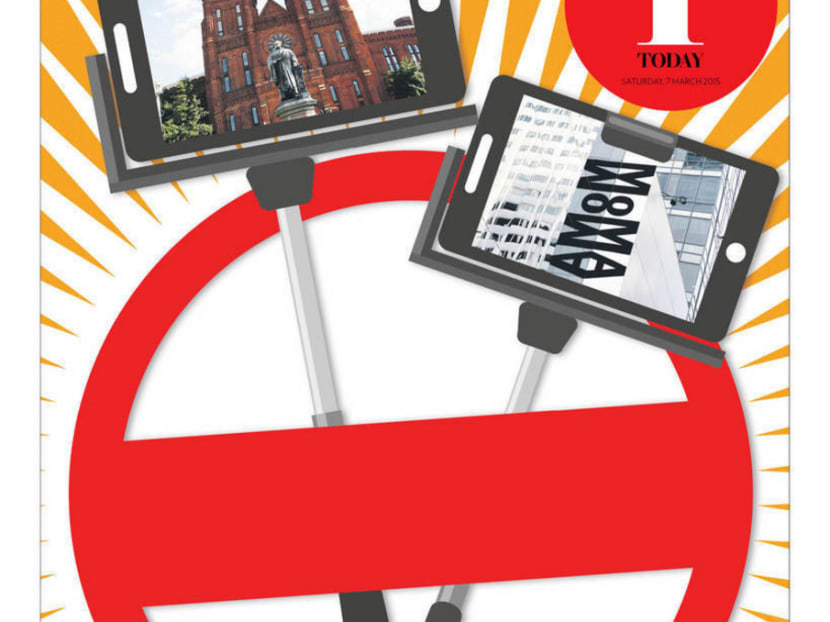Where in the world can I use my selfie stick
You’re going on holiday and want those Instagram photos to mark the occasion. What’s a must-pack item? The selfie stick? Sure. Except if you’re going to visit certain institutions in the United States. The dislike of the stick among America’s museums has intensified, with news that the Smithsonian Institution, which has 19 museums and galleries in the Washington DC and New York areas, also implemented a ban earlier this week, citing the need to protect visitors and museum objects, especially in crowded conditions.

You’re going on holiday and want those Instagram photos to mark the occasion. What’s a must-pack item? The selfie stick? Sure. Except if you’re going to visit certain institutions in the United States. The dislike of the stick among America’s museums has intensified, with news that the Smithsonian Institution, which has 19 museums and galleries in the Washington DC and New York areas, also implemented a ban earlier this week, citing the need to protect visitors and museum objects, especially in crowded conditions.
“We encourage museum visitors to take selfies and share their experiences — but leave the selfie sticks in their bags,” the Smithsonian said in a statement.
“I can’t think of any recent change that’s similar to this,” spokesman John Gibbons said. “I don’t think you could have predicted 10 years ago that there would even be such a thing, let alone that it would be so popular.”
Gibbons added that the rule change was not inspired by any particular incident, but was meant to be preventative.
The device, which became wildly popular last year — not only in Asia, but also all around the world — is banned from dozens of venues in the US, Australia and Canada, and many in the United Kingdom.
The Museum of Modern Art in New York, Getty Center in Los Angeles, the Smithsonian’s Hirshhorn Museum, National Air and Space Museum and Sculpture Garden in Washington DC, the Museum of Fine Arts in Boston and the Rhode Island School of Design Museum are only some of the places stateside where the selfie stick is banned.
Other venues around the world where the stick is not welcome include some English Premier League football stadiums, most notably Tottenham Hotspur’s White Hart Lane, which kick-started the stadium ban that was soon followed by Arsenal, Manchester United and Manchester City, classifying the stick as an “offence weapon” in the same league as knives and fireworks. Even music venues in England don’t want it: London’s O2, the O2 Academy Brixton and the SSE Wembley Arena have banned it. “Our advice is don’t bring it and stick with the tried-and-tested use of an arm,” said an SSE Wembley Arena spokesman.
Selfies taken without the stick have become something of an institution following the introduction of Museum Selfie Day. The invention of Mar Dixon, a digital culture campaigner from Shropshire, Museum Selfie Day is an annual event when visitors take a photograph of themselves with a painting or item with the hashtag #MuseumSelfie. While keen on using selfies as a way of encouraging people to visit museums, Dixon has expressed her disapproval of the stick. “I agree — ban Selfie Sticks,” she posted on Twitter.
In Singapore last year, selfie sticks were banned at outdoor events and parties such as Celebrate SG50 and ZoukOut. The Singapore Sports Hub also does not allow event-goers to use selfie sticks in the National Stadium, said its website.
For museums, it’s a different story. Most employ the same photography policy: You can take pictures for personal non-commercial purposes as long as you do not infringe copyright (or in some cases, use flash photography). Photography in paid-for exhibitions tends to be banned, as is any photographic equipment more complex than a flash (yes, you can leave your tripods and monopods at home too).
Some are okay with the stick, such as Britain’s Victoria and Albert Museum. “Visitors are currently permitted to use selfie sticks in line with the museum’s general policy on photography and filming with a handheld camera for personal use,” said a spokesman, with the caveat that its policies are reviewed “on an ongoing basis”.
This review process includes taking into account the safety of visitors and collections, so if anyone gets bonked on the head, selfie sticks will be prohibited, although they have appeared in V&A exhibitions.
A recent survey of Instagram posts that include mentions of tourist attractions and the world “selfie” showed the Eiffel Tower in Paris is the most popular place to take a selfie. On average, more than one million selfies are taken every day, the research said, with 10,700 found to have been taken against the backdrop of the French landmark. AGENCIES





